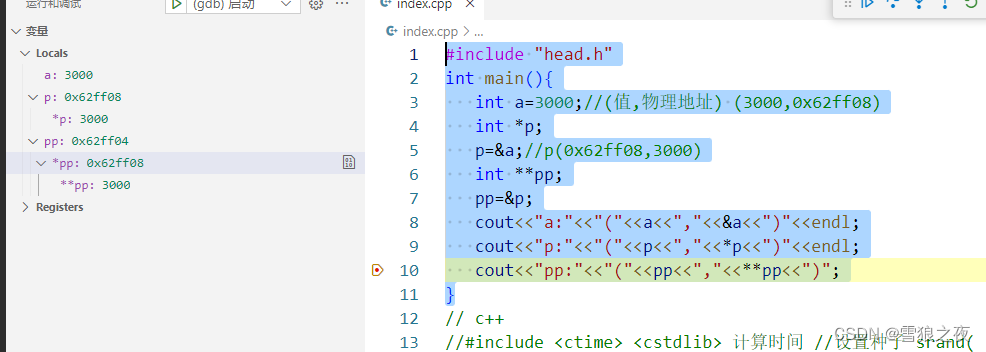您现在的位置是:首页 >学无止境 >c++自学笔记(陆续更新)网站首页学无止境
c++自学笔记(陆续更新)
本笔记为从菜鸟教程边学边记录的笔记---》C++ 教程 | 菜鸟教程
面向对象程序设计
-
封装(Encapsulation):封装是将数据和方法组合在一起,对外部隐藏实现细节,只公开对外提供的接口。这样可以提高安全性、可靠性和灵活性。
-
继承(Inheritance):继承是从已有类中派生出新类,新类具有已有类的属性和方法,并且可以扩展或修改这些属性和方法。这样可以提高代码的复用性和可扩展性。
-
多态(Polymorphism):多态是指同一种操作作用于不同的对象,可以有不同的解释和实现。它可以通过接口或继承实现,可以提高代码的灵活性和可读性。
-
抽象(Abstraction):抽象是从具体的实例中提取共同的特征,形成抽象类或接口,以便于代码的复用和扩展。抽象类和接口可以让程序员专注于高层次的设计和业务逻辑,而不必关注底层的实现细节。
hello word
#include <stdio.h>
#include <windows.h>
#include <iostream>
using namespace std;
int main()
{
SetConsoleOutputCP(65001);
cout << "hello world!"<<endl; //也可以用
代替endl;都是换行的意思
return 0;
}
变量别名!
#include <iostream>
using namespace std;
int main()
{
typedef int it;//int的别名 是it
it a;//以后就可以用it来定义变量
}枚举类型
默认情况下,第一个名称的值为 0,第二个名称的值为 1,第三个名称的值为 2,以此类推。但是,您也可以给名称赋予一个特殊的值,只需要添加一个初始值即可。例如,在下面的枚举中,green 的值为 5。
#include <iostream>
using namespace std;
int main()
{
enum {green,blue=5,red} c;
c=red;
cout <<"sdsdds" <<c;
}
类型转换-静态转换
#include <iostream>
#include <typeinfo>
#include <windows.h>
using namespace std;
int main()
{
SetConsoleOutputCP(65001);
//这个是c++的断点 这配置c语言也支持断点
int a = 10;
//静态转换 数据 类型;
float b=static_cast<float>(a);
cout <<b<<"是"<<typeid(b).name()<<"类型";
}
你像打印 i 就是int 打印 f 就是float;就是类型首字母
类型转换-常量转换
#include <iostream>
#include <typeinfo>
#include <windows.h>
using namespace std;
int main()
{
SetConsoleOutputCP(65001);
//这个是c++的断点 这配置c语言也支持断点
const int a = 10;
//常量转换
int &b=const_cast<int&>(a);
b=11;
cout << b;
}
extern关键词用法
顺带你还知道下 .cpp怎么引入另一个.cpp的文件。
参考博主写的另一篇博文===》c++的extern用法理解_雪狼之夜的博客-CSDN博客
局部变量
局部作用域:在函数内部声明的变量具有局部作用域,它们只能在函数内部访问。局部变量在函数每次被调用时被创建,在函数执行完后被销毁。
#include <iostream>
using namespace std;
int main()
{
int a=2;
cout<<"局部变量a="<<a<<endl;
}
全局变量
全局作用域:在所有函数和代码块之外声明的变量具有全局作用域,它们可以被程序中的任何函数访问。全局变量在程序开始时被创建,在程序结束时被销毁。
#include <iostream>
using namespace std;
int a=2;
int main()
{
cout<<"全局变量a="<<a<<endl;
}![]()
块变量
块作用域:在代码块内部声明的变量具有块作用域,它们只能在代码块内部访问。块作用域变量在代码块每次被执行时被创建,在代码块执行完后被销毁。
#include <iostream>
using namespace std;
int main()
{
int a=1;
{
int a=2;
cout<<"块变量a="<<a<<endl;
}
cout<<"函数变量a="<<a<<endl;
}
<string>
#include <iostream>
#include <string>
using namespace std;
int main()
{
string a="hello world";//或者写成string a("hello world") 等效
a+=" 你好啊";
cout<< a<<endl;
}![]()
类
#include <iostream>
using namespace std;
class Box{
public:
int a;
int b;
int chen(void){ //申明和定义在类里面
return a*b;
};
void setVal(int,int);//先在类里面申明
};
void Box::setVal(int x,int y){//在类外面定义 范围解析运算符 ::
a=x;
b=y;
};
int main(){
Box box1;
box1.setVal(3,2);
cout << box1.chen();
}
类私有成员
#include <iostream>
using namespace std;
class Box{
private://类私有,只有成员可以调用 也就是说你不可以通过box1.a来调用 ,这些变量其实你默认不用写private 这个变量,只要放在最上面他默认就是 私有
int a,b;
public://
int c=10;
int chen(void){ //申明和定义在类里面
return a*b;
};
void setVal(int,int);//先在类里面申明
};
void Box::setVal(int x,int y){//在类外面定义
a=x;
b=y;
};
int main(){
Box box1;
cout<< box1.c<<endl;
box1.setVal(3,2);
cout << box1.chen();
}
类
看博主另一篇博文=》c++类 笔记_雪狼之夜的博客-CSDN博客
.cpp调用 .cpp和h的demo
看博主另一篇博文=》.cpp调用 .cpp和h的demo_雪狼之夜的博客-CSDN博客
数组
C++ 不允许返回一个完整的数组作为函数的参数。但是,您可以通过指定不带索引的数组名来返回一个指向数组的指针。
你不能简单地返回指向局部数组的指针,因为当函数结束时,局部数组将被销毁,指向它的指针将变得无效。
C++ 不支持在函数外返回局部变量的地址,除非定义局部变量为 static 变量。
#include "head.h"
int* arrFun(){
static int arr[3]={5,4,10};
return arr;
}
int main()
{
int *arr=arrFun();
cout<<arr[1];
}
函数动态分配数组
使用动态分配数组需要在函数内部使用 new 运算符来分配一个数组,并在函数结束时使用 delete 运算符释放该数组
#include "head.h"
int* arrFun(int size){
int* arr=new int[size]; //这里也可以直接写3
arr[0]=1;
arr[1]=10;
arr[2]=3;
return arr;
}
int main()
{
int *arr=arrFun(3);
cout<<arr[1];
delete[] arr;
}
数组指针
#include <iostream>
using namespace std;
const int Max=3;
int main(){
int arr[Max]={100,200,300};
int *p;
p=arr;
for(int i=0;i<Max;i++){
cout << "arr["<<i<<"]="<<*p<<endl;
p++;
}
}
今天也算理解了,p=arrr其实等价于p=&arr[0] ,也就是说数组指针也可以变成下面这种写法。
我写一个从a[2]往a[0]输出的操作,你们理解下
#include <iostream>
using namespace std;
const int Max=3;
int main(){
int arr[Max]={100,200,300};
int *p;
p=&arr[2];//等价于p=&arr[0] 也就是说
for(int i=0;i<Max;i++){
cout << "arr["<<i<<"]="<<*p<<endl;
p--;
}
}
数组指针另一种写法
#include <iostream>
using namespace std;
const int Max=3;
int main(){
int arr[Max]={100,200,300};
*(arr+2)=500;
cout <<arr[2]<<endl;
arr[2]=100;
cout <<arr[2];
}
*(arr+2)其实就等于 arr[2]; 也就说说 等价于下面
#include <iostream>
using namespace std;
const int Max=3;
int main(){
int arr[Max]={100,200,300};
int *p;
p=arr;
cout<< *(p+2);
} ![]()
C++ 指向指针的指针
#include "head.h"
int main(){
int a=3000;//(值,物理地址) (3000,0x62ff08)
int *p;
p=&a;//p(0x62ff08,3000)
int **pp;
pp=&p;
cout<<"a:"<<"("<<a<<","<<&a<<")"<<endl;
cout<<"p:"<<"("<<p<<","<<*p<<")"<<endl;
cout<<"pp:"<<"("<<pp<<","<<**pp<<")";
}

引用
#include "head.h"
int main()
{
int a,b;
int& x=a;//引用
a=3;
int *y;//指针
y=&b;
b=10;
cout<<x<<endl;
cout<<*y<<endl;
y=&a;
cout<<*y<<endl;
}
指针交换值
#include <iostream>
using namespace std;
int main()
{
extern void ptrFun(int*,int*);
int a=1,b=5;
ptrFun(&a,&b);
cout<<"a:"<<a<<endl;
cout<<"b:"<<b;
}
void ptrFun(int *x,int *y){
int a;
a=*x;
*x=*y;
*y=a;
}
引用交换值
#include <iostream>
using namespace std;
int main()
{
extern void ptrFun(int&,int&);
int a=1,b=5;
ptrFun(a,b);
cout<<"a:"<<a<<endl;
cout<<"b:"<<b;
}
void ptrFun(int& x,int& y){
int a;
a=x;
x=y;
y=a;
}
引用改变数组值
// #include <iostream>
// using namespace std;
#include "head.h"
double arr[]={10.23,55,17};
int main()
{
extern double& arrFun(int);
arrFun(1)=11.77;
cout << arr[1];
}
double& arrFun(int x){
double& ref=arr[x];
return ref;
}






 U8W/U8W-Mini使用与常见问题解决
U8W/U8W-Mini使用与常见问题解决 QT多线程的5种用法,通过使用线程解决UI主界面的耗时操作代码,防止界面卡死。...
QT多线程的5种用法,通过使用线程解决UI主界面的耗时操作代码,防止界面卡死。... stm32使用HAL库配置串口中断收发数据(保姆级教程)
stm32使用HAL库配置串口中断收发数据(保姆级教程) 分享几个国内免费的ChatGPT镜像网址(亲测有效)
分享几个国内免费的ChatGPT镜像网址(亲测有效) Allegro16.6差分等长设置及走线总结
Allegro16.6差分等长设置及走线总结